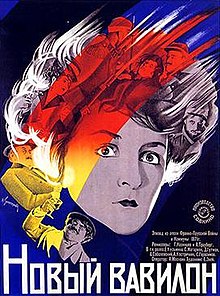 I spent the last two days repeatedly viewing – and (as the orchestra’s pianist) participating in – screenings of the 1929 Soviet silent film The New Babylon, with Dmitri Shostakovich’s score performed by PostClassical Ensemble led by Angel Gil-Ordóñez.
I spent the last two days repeatedly viewing – and (as the orchestra’s pianist) participating in – screenings of the 1929 Soviet silent film The New Babylon, with Dmitri Shostakovich’s score performed by PostClassical Ensemble led by Angel Gil-Ordóñez.
Every aspect of this astonishing movie has surged in my comprehension and estimation – to the point, for instance, that I have no doubt that Shostakovich’s score, however little known (there is no suite by the composer), is one of the most formidable ever composed for film.
Anton Fedyashin, who took part in an eventful hour-long post-screening conversation Friday night, began with a comment I found instantly revelatory – that The New Babylon differs from other Russian silent films, also products of the feverish experimentalism of the Soviet 1920s, for combining social context and ideology with individualized human drama. That is: this polemical celebration of the Paris Commune of 1871 is infiltrated by a gritty love story, mating a fiery Communard with a hapless, placeless soldier. This is no sentimental diversion (like, say, the gratuitous love story inflicted on James Cameron’s Titanic). Rather, its shattering hopelessness meshes brilliantly with the film’s fierce depiction of class warfare and political betrayal.
The New Babylon marks the first collaboration of Shostakovich and the master director Grigory Kozintsev – initiating a historic forty-year relationship ending with the greatest of all cinematic Shakespeare adaptations: their epic King Lear. The latter 1971 film is enriched by the same double aspect: added to Shakespeare’s human drama is a social dimension inspired, in part, by the oppressed multitudes inhabiting Mussorgsky’s Boris Godunov (cf my previous blog: Shostakovich and the Fool).
As with Mussorgsky, as with the Soviet King Lear, The New Babylon miraculously intermingles the personal and with the epic. In fact, the lead actors – Yelena Kuzmina as the shopgirl and Andrei Kostrichkin as the soldier – deliver two of the most riveting cinematic performances I have ever encountered. The seething discontent and confusion of Kostrichkin’s soldier contradict the stylized “eccentricity” of the film’s general aesthetic. I should also mention, as one of the film’s many seductions, the poetic homages to Daumier and Degas – which, however, co-exist with biting lampoons whenever “bourgeois” Paris is on display. How Kozintsev and Shostakovich get away with such a plethora of stylistic and thematic ingredients I do not know.
As I learned from Anna Lawton, who guided our post-screening discussion Saturday afternoon, the Factory of the Eccentric Actor created by Kozintsev and Leonid Trauberg (who co-directed The New Babylon) promulgated a manic aesthetic predilection for the circus, Charlie Chaplin, and other antidotes to pompous high culture; Eccentric antipathy to linear narrative was compatible with the signature montage effects of Soviet silent film.
The young Shostakovich feasts on cinematic montage. In 1929, he was all of 23 years old. Five years previous, he completed a First Symphony more impressive than anything by the young Mozart; it already encapsulates the irony and (incredibly enough) the pathos of his mature voice. In The New Babylon, his debut film score, he flaunts his enfant terrible energies. But as the film moves from satire to tragedy, Shostakovich’s emotional range proves limitless. And he is already a master of shaping a cinematic trajectory. Check out, for instance, the crescendo of imagery and music – of dissolute revelry — in the sequence directly preceding the percussive tramp of the invading Prussian army that lays siege to Paris and precipitates the Commune: the pertinent musical coda begins at 15:50 of this youtube link. (The frisson of this passage last weekend, in the 400-seat AFI Silver Spring Theater with a 17-member pit orchestra including a hard-driving string quintet, was electrifying; the invaluable DVD version of this film, with a larger band, is not comparably impactful.)
Montage is omnipresent in The New Babylon, typically juxtaposing decadence with travail. Shostakovich adds a third plane of expression. E.g.: here is “Preparations,” a sequence shifting between preparations for a musicale and for a bloody military encounter, at 33:00 of the film.
Such jolting contradictions in content and tone engender an active response. The film jostles feeling and thought. Notwithstanding its ideological message, it doesn’t spoon-feed the masses as would Steven Spielberg and John Williams decades later. Here are a couple of further examples:
The Commune has been toppled. The revolutionary shopgirl has been arrested. The soldier is trying to find her. Paris is now repopulated by the bourgeoisie. Shostakovich (for once) ignores this decadent spectacle and scores the Soldier: 1:18:00 of the film.
Earlier on, the bourgeoisie sing the Marseilles while French soldiers prepare to attack French citizens. Shostakovich responds with feigned relish, then decomposes their song via the intervention of an Offenbach can-can: 54:40 of the film. This compositional tour de force subverts a visceral response with a political critique. Our shifting perspective on the goings-on keeps us alert. Meanwhile, the soldier himself can’t decide which side he’s on.
The New Babylon is art, it is propaganda, it’s a political tract, it’s an aesthetic anthem. For the young Shostakovich, it was doubtless a heady learning experience. Its impact on his future development is more than ponderable.

Check out “Mother” made by Pudovkin several years earlier for a compelling story of individuals in a Soviet movie. Some cinematographic things anticipating later movie as well.
Sorry, that was a bad link, Try this: